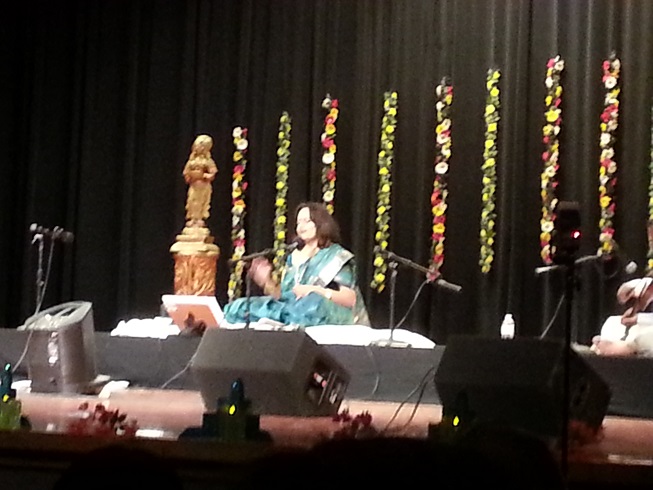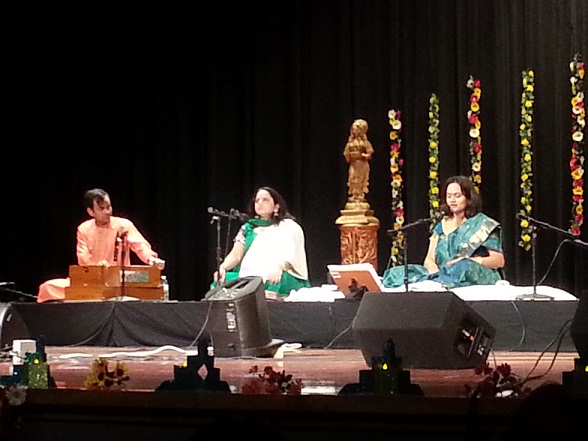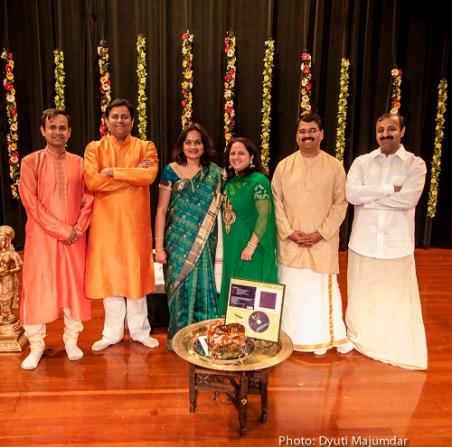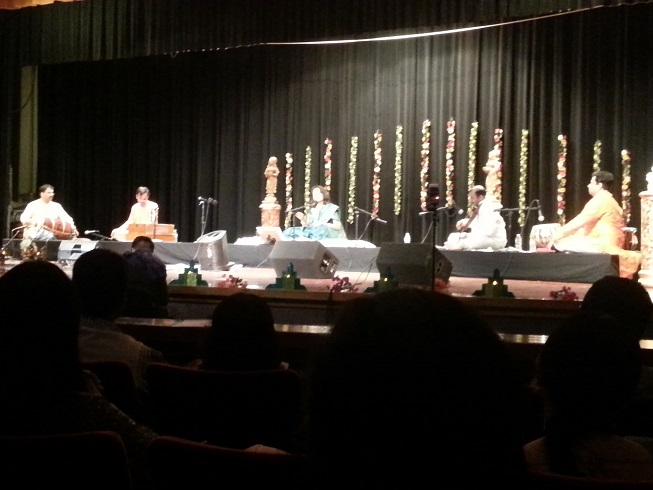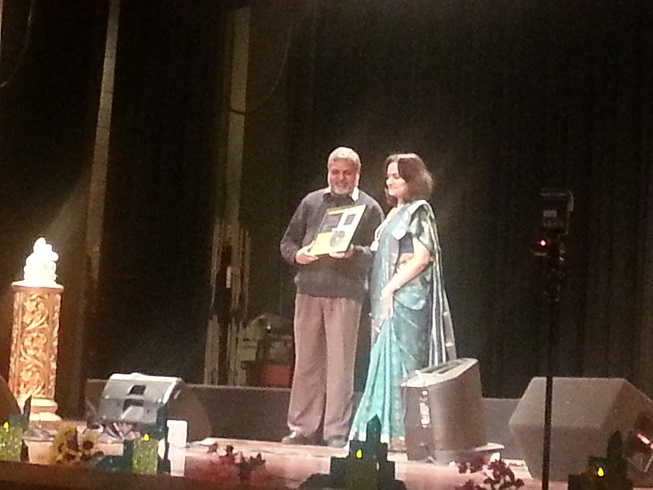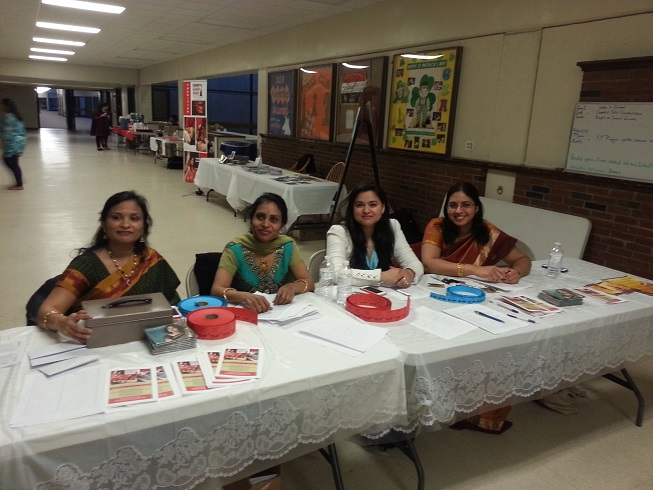Contribute
| Carnatic Cadenzas: Music, Magic & The Melting Pot! |
Pallavi Nagesha
03/13/2014
(This article is sponsored by Masala Art)
A pebble drowns and surfaces from the ebb and flow of the mighty ocean. It is polished by the deluge, and receives a facet that only the water could create. I am that pebble and Carnatic Cadenzas the deluge! On March 8, 2014, the International Women’s day, Dr. Deepti Navaratna presented an uncommon classical music concert. From the musicians she chose and the artists she collaborated with, to the songs she picked and her dulcet voice, Deepti’s performance at Keefe Tech was a deluge that submerged the audience in a plethora of sensations.
Deepti touched the Rasika in me with her invocation. A poem by the greatest romantic poet of the era, Kalidasa, whose words stir the heart, and move the soul like no other. From here on, there was no turning back. Wave after wave of magical notes washed over me. Some were riptides, just playing with the sand beneath my feet, while others were breakers upon which I could ride into the sunset. Deepti surfed these waves, between genres and styles effortlessly. She followed her invocation with pure Carnatic classic in raaga Hamsadhwani. Saint Kanakadasa’s lyrics (Nammama Sharade) seemed to fit the moment so perfectly. It hails the universal mother for bringing knowledge into the world. The piece was expertly accompanied by the pulsating rhythms of the mridangam of Mahalingam Santhanakrishnana and the silken sounds of strings of K.V.S Vinay’s violin.
Quoting Tagore, “Music fills the infinite between two soulsâ€, the MC, Anandini Sekar introduced the next piece. And indeed, Deepti melded the Carnatic body to the Hindustani soul with her Carnatic Thumri. Epitomizing Lord Krishna as the one who contains the universe, Deepti brought North and South, old and new into this playfully thoughtful song. I was instantly transported to Mathura, a gopika with a stirring to meld into the supreme one as I listen to His magical flute. Was it the music with the melodious sounds of Dilp Acharya’s harmonium, or the transcendental poetry of D.V. Gundappa? Or was it the exquisite interpretation of the entire experience in Deepti’s voice?
Deepti then introduced another face to her brilliant performance. Sunayana Kachroo, an accomplished poet, recited a playful, original ras leela, while Deepti performed a timeless Annamacharya kriti, Bhavayami Gopalabalam. The incredible journey continued with another original poem based on the inimitable Gulzaar sahib’s “Dil Dhoonta Haiâ€. Space and time seemed to expand as the pair explored connection through separation. “I need my space!†joked Ms. Kachroo, talking about a teenager’s need for retrospection. This refrain, familiar to most parents transported me to a land of rhetorical what ifs, as the poetry, the melody and the strange culmination of dreams unfolded on stage.
Just as I thought I had imbibed all the emotions I could handle, Deepti stirred in Ghalib. “Ishrate Qatra†rendered in a garland of Carnatic raagas was simply psychedelic! I am quite partial to Ghalib and can only listen to his poetry rendered by a select few. I am glad that Deepti is now on that list.
A now en-sanded audience was then sent into rapture with a rendition of Annamacharya’s Srimannarayana. The raaga, Bowli, is believed to invoke devotional frenzy. The poignant lyrics rendered with utter devotion by Deepti, Vinay and Mahalingam, simply transcended this plane.
Deepti’s passion of world music is not just evident in her juxtaposition of many genres, it runs strong in the way she approaches her music. The next item demonstrated her mastery over the many forms of music. Like tributaries that join and separate effortlessly and gracefully, Deepti sailed between a Turkish folk song and a Lalgudi Jayaraman composition in Ahir Bhairav. Rajesh Pai gave her perfect accompaniment, where he himself waltzed from the tabla to the dholak and back. Dubbed “a global jam session†by Anandini, this part of the concert firmly establishes Deepti as a world music virtuoso and validates her knack to effortlessly move through genre, time and space.
She went on to stun the audience with her knowledge of diverse musical genres when she rendered Muthuswamy Dikshitar’s composition, Vande Meenakshi to Mozart’s Symphony No. 25. The piece in G minor was played on the violin by Abby Swindler and on the mandolin by Jacob Means. My 9 year old daughter, a string player herself, was completely floored as was the entire auditorium!
Deepti’s soulful rendition of Sant Brahmanand’s bhajan followed by the beautiful Desh Thillana composed by Lalgudi Jayaraman, delivered the peak and crescendo that aptly concluded her concert. This pace and mood was carried through her Mangalam, one of my favorites, a Ramadas composition.
The event ended on a high note with Dr. Manju Sheth releasing Deepti’s very first music Album in the Alchemy Project, Ka. This experiment with world music is composed by Shrish Korde and rendered in Deepti’s beautiful voice. Manju ji spoke eloquently about her journey with Deepti and said that she was “Educated, Entertained and Enthralled (a) music program does not get better than that.â€
I caught up with Deepti after the event and asked her how she arrived at this alchemy. She says that the concept for Cadenzas was “born with idea of creating transformative experiences with Carnatic music.†She hopes that “in the process of exploring new possibilities with Carnatic music, people will discover its ageless wisdom and be transformed – a beautiful two way street.†And a true alchemy it is folks, with each genre stitched together in this colorful quilt. Distinct in their identities and fused in beauty. Her “musical experiments†at the New England Conservatory primed her to undertake this unique colorful journey and yet ‘keep the genre-identity intact as they play games with each other.â€
To sum up, “Chashm ko chahiye har rang mein va ho jana†or the eye/soul must fill with intense pathos! Carnatic Cadenzas has set a bar in classical world music. I am sure we will witness more soul-stirring performances from Deepti and her ensemble. Deepti’s grasp of musical nuances is outstanding and her voice is like honey, but it was her vocal isometrics that took my breath away. If Nadia Comăneci could sing, it would sound like this.
Thoughts on Carnatic Cadenzas
Ajey Pandey
I went to see Deepti Navaratna perform what she called Carnatic Cadenzas – an experimental mix of Hindustani, Carnatic, Middle Eastern, and even a bit of Western music. It was certainly an eclectic concert, even to a teenager who generally only listens to subwoofer stress tests.
Ms. Navaratna really surprised me with her skill in numerous styles. She could conjure the percussive power of Carnatic music, float with the smoother melodies of Hindustani music, and even bring in music that normally would not be heard in an “Indian classical†concert.
Two songs especially showed her love of exploration. One, called “The Raaga Gypsy,†juxtaposed two different styles: a bombastic Persian chant and a flowing Hindustani interlude. She seamlessly changed her tone between sections, almost sounding like two separate people, and despite the drastic changes in dynamics and form, none of the transitions were uncomfortably jarring. The second song, “Vande Meenakshi,†was even more eclectic: a Western violinist and a mandolin player joined Ms. Navaratna for a surprising fusion of Irish folk, Indian classical, and a bit of Mozart. It actually worked very well; the trio deftly meshed lilting triplets, vibrating Hindustani-style vocals, and melodies ripped straight out of violin sonatas into a beautiful synthesis.
Sunayana Kachroo also contributed some poetry during the concert. I didn’t know many of the words, but I could connect to the musicality of her words – the rhythms, the inflections, the refrains. Even through the few Hindi words I did catch, I could understand her message of spiritual relaxation.
I walked out of the concert inspired. In my head, I was already pulling together melodies and sounds I had heard into new renditions with my own synthesizer-driven twist. I now have an urge to experiment a bit, meld my own electronic compositions with Indian influences, and challenge my own perception of music.
It’s going to be fun.
You may also access this article through our web-site http://www.lokvani.com/
